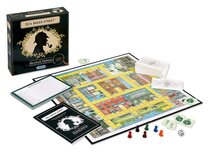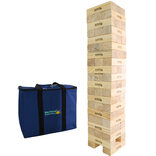The Rules of Pachisi & Chaupur
Pachisi, also known as "Twenty Five", is the national game of India and has been played there for millennia. Pachisi should not be confused with the modern commercial Western derivatives Ludo (UK), Parchís (Spain) and Parcheesi (USA), which are simplified and less skilful or indeed Uckers (a naval version of Ludo). The variant and less well-known ancestor Chaupar (also Chaupur or Chaupad) is also given. There are no standard rules and so the instructions are simply typical of a number of existing variants.
See also: Ludo and Pachisi.
Pachisi
Equipment
The game of Pachisi is played on a board in the shape of a cross, each arm being divided into three adjacent columns of eight squares. Three of the squares on each arm are highlighted with a cross or some other distinguishing mark - the middle square at the end of each arm plus the fourth square in from the end of the arm on either side. These squares are called "castles". The middle of the cross forms a large square called the Charkoni. Boards can be of any material although commonly these days, it is made from strong cloth, with the gaming pattern embroidered onto it. Sixteen beehive shaped pieces are used, four in black, four in green, four in red and four in yellow. The element of chance is provided by 6 small cowry shells that, when thrown, indicate an amount according to the following rules:
- 2 cowries with mouths up - 2
- 3 cowries with mouths up - 3
- 4 cowries with mouths up - 4
- 5 cowries with mouths up - 5
- 6 cowries with mouths up - 6 + grace
- 1 cowries with mouths up - 10 + grace
- 0 cowries with mouths up - 25 + grace
- A grace is a special allowance which is a critical part of the game.
Preparation and Objective
The game is for four players playing as partners. Partners sit opposite each other; Yellow and Black play against Red and Green. To begin, the pieces are placed in the Charkoni. Each player throws the cowries - highest plays first and thereafter turns are taken in an anti-clockwise direction. It is possible to play the game with two players. In this case, play proceeds exactly as if there were four players but one player plays Yellow and Black and the other plays Red and Green. Each player's objective is to move all four pieces down the middle of the nearest arm, around the edge of the board in an anti-clockwise direction and then back up the same arm to finish back in the Charkoni. The pieces are placed on their sides when returning up the middle of the arm towards the Charkoni in order to distinguish them from pieces just starting. Pachisi is a team game, and is only won when both partners have all eight pieces home. As with all true team games, working together is the key to winning.
Play
Moves are decided by throws of the cowry shells. To begin a turn, the player throws the cowries. The player moves a piece the number indicated. If a grace is thrown, the piece moved can be played out of the Charkoni onto the board, if desired, and the player is allowed another throw and so on until a 2, 3, 4 or 5 is thrown. The first piece to leave the Charkoni for each player can depart using any number. All subsequent pieces are only allowed to start or re-enter the game using a grace throw. More than one piece from the same side can occupy the same square. A piece is not allowed to finish on a castle square that is occupied by one or more enemy pieces. If a piece finishes on a non-castle square inhabited by one or more enemy pieces, the enemy pieces are captured. Captured pieces are returned to the Charkoni from where they must start again with a grace. A player making a capture is allowed another throw of the cowries to be taken immediately. Moving is not compulsory and a player may decide not to move having thrown the cowries. This is typically done in order to remain safely within a castle square or to help a partner. A common strategy is for a piece to remain upon the castle square at the end of the third arm until a 25 is thrown, thus allowing that piece to finish without risk. It is possible for a piece, upon completing its circuit, to carry on around the board for a second time. This is often done in order to assist a partner who is lagging behind. Pieces finish the game by re-entering the Charkoni, having completed a circuit of the board. However, a player is only allowed to move a piece into the Charkoni by throwing the exact number required.
Variations
The rules to Pachisi itself vary from place to place. The rules given above are chosen from amongst variations to be the most straightforward. Here are some alternative rules that are commonly played. If the game seems too simple, Masters Games recommends either using the last variation given to increase the skill level or alternatively, try Chaupar.
- Seven cowry shells can be used instead of six. Different amounts can be allocated to the different permutations of cowries. Sometimes there are only 2 grace numbers - 10 and 25.
- Pieces can finish in the Charkoni only with a grace throw.
- A square occupied by two or more pieces cannot be passed by an opposing piece. This rule, which is possibly a non-Indian modern invention, naturally changes tactics significantly since, whereas in the basic rules outlined above it is inadvisable to put two pieces from the same side on the same square, under this variation, putting two pieces from the same side together is a good defensive strategy.
- If three graces are thrown in a row, a penalty is incurred. The commonest penalty is for the third throw to be ignored and the next turn to be missed.
- Some versions play the grace throws differently. Instead of using the actual amount of 6, 10 and 25 to enter or re-enter a piece, the amount thrown can only be used to move a piece already on the board in the normal way.
- The grace is played separately and allows a single piece to be moved one square on the board or a single piece to be moved from the Charkoni onto the first square of the arm.
- 1 piece 3 times
- 1 piece twice and another once
- three pieces once each.
Chaupar
A very similar but more skilful, complex and older game game called Chausar, Chaupar, Chapur or Chaupad also exists (there are several more spellings and names - this game probably holds the record for number of variations of a name!). This is the form of the game that the Emperor Akbar 1 of India would have played using slave girls for pieces in the sixteenth century and the game probably dates back to well before the time of Christ. Again, there are no standard rules, but Masters Games has compiled a typical set of rules that should be enjoyable. Play is the same as Pachisi with the following differences:
- Three long dice are used instead of cowry shells. Each long die has 1 and 6 on opposing faces and 2 and 5 (or sometimes 3 and 4) on the other faces.
- There are no graces or extra throws.
- Castle squares are absent or, if played upon a Pachisi board, are ignored.
- Pieces start on specific squares instead of the Charkoni although captured pieces are returned to the Charkoni. To prepare to start the game, position each set of four pieces on squares 6, 7, 23 and 24 from the Charkoni.
- Pieces can be melded together to form a "super-pieces". If two pieces of the same shade land on the same space, then those pieces are lumped together and thereafter play as a single piece with double the power. Triple and quadruple pieces can be formed in the same way. Conglomerate pieces move using the throw of the dice as if they were a single piece. However, a double piece can only be captured by a double, triple or quadruple piece, a triple piece is only vulnerable to a triple or quadruple piece and a quadruple piece can only be captured by another quadruple piece.
- Each throw can be split into its constituent parts and shared across the pieces. For instance, if a 1, 2 and 6 is thrown, a player might choose to move one piece 9 squares or three pieces 1, 2 and 6 squares respectively. It would also be possible to move a piece 2 squares to form a double piece and then move the double piece 7 further squares, for instance.
- A throw cannot be passed in whole or part unless a player cannot move.
- An exact throw is required for a piece to get home.
- All the blacks must be got home before a yellow piece can go home. All the reds must be got home before a green piece can go home.
A Chaupar Variation from Haryana
Naresh Verma from Haryana in Northern India contributed the following rules for the game of Choupar (or Chopat) that they play there. It is played in the same way as above with the following modifications:
- Partners sit opposite with 4 pawns each
- Partners can any of the 8 pawns owned by both partners
- You have to taken at least one pawn of the opposition before any of your pawns can enter the Charkoni
- If a dice roll of 1 1 2 is thrown, a Superpawn (conglomerate piece) will move 2 squares plus a single pawn must also move 2 squares
- If a dice roll of 2 2 5 is thrown, a superpawn must move 4 squares plus a single pawn must move 5 square
- If a dice roll of 6 6 2 is thrown, a superpawn must move 12 squares plus a single pawn must move 2 squares
These rules are provided by Masters Traditional Games, an Internet shop selling quality traditional games, pub games and unusual games. For general information or for copying and copyright, see our Rules Information page.
Our rules are comprehensive instructions for friendly play. If in doubt, always abide by locally-played or house rules.
Copyright James Masters, 2025. All rights reserved.









































